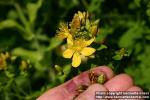Every now and then I get email: 'My son/daughter/grandson/little-sister/other-kid-I-know has an assignment at school. He/she/it picked herbs. Do you have any suggestions?'
Here's a couple I came up with:
Project 1: The strangeness of St.John's wort.
 St. John's wort (Hypericum) in flower is yellow, but you can get it to yield a red color in at least three ways:
St. John's wort (Hypericum) in flower is yellow, but you can get it to yield a red color in at least three ways:
- rub the yellow flower, watch the red juice on your fingers
- make an oil out of the fresh yellow flowers, watch them turn red over the course of a week or so (preferably in the sun) (use the oil as a skin oil when it's done)
- make an alcohol extract of fresh or dried flowers, watch it turn red
Can you think of more ways to get red out of Hypericum?
Project 2: Establishing a diuretic index.
This one actually was suggested to me by Christopher Hedley (thanks!).
Give dandelion (Taraxacum) leaf or root tea to a whole class and see how many have to leave to pee within the span of 1,5 hours - you do not tell them in advance what you are looking for. The next day you repeat the feat with burdock (Arctium) leaf or root. And then you take birch (Betula) leaves. And then perhaps mint (Mentha) leaves, just so the class doesn't have to pee that much, every day. And then perhaps Equisetum arvense as a decoction (= you boil it, instead of making a normal tea).
The result can be written up as the diuretic index for the plant you tested. It's smart to do the index as percent of the whole - burdock will yield something like 80 % (I'm told), while dandelions will stay far lower.
Project 3: Essential oils.
Have a friend put a drop of essential oil of peppermint onto your little toe and wait. How many minutes until you taste it on your tongue?
Essential oil of peppermint isn't actually herbal, it's aromatherapy, but it's fun anyway. And remember that you can only use a very few essential oils straight on your skin - peppermint and lavender are two; be careful with other essential oils. How to be careful with essential oils: first, check that the oil you are thinking of using isn't toxic; second, dilute it by adding only 1-2 drops of oil to 1-2 tablespoons of cooking oil, before applying it to your skin.

